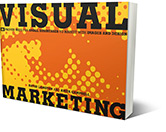The survival of a communications tool from the “old media” of print will be based on how effective it is in the new digital economy.
 Your company’s website is the number one communications platform for promoting and expressing your brand and in turn for positioning and selling your products and services. How does this affect your marketing strategy? How will people remember your name or find your website? The survival of a communications tool from the “old media” of print will be based on how effective it is in the new digital economy. But before we send out that condolence cardor email, let’s take a look at what the different media types offer us when we create a marketing communications plan.
Your company’s website is the number one communications platform for promoting and expressing your brand and in turn for positioning and selling your products and services. How does this affect your marketing strategy? How will people remember your name or find your website? The survival of a communications tool from the “old media” of print will be based on how effective it is in the new digital economy. But before we send out that condolence cardor email, let’s take a look at what the different media types offer us when we create a marketing communications plan.I like the bumper sticker that says, “If you can read this then you are too close to me.” It’s a perfect example of a communication tool that takes advantage of its unique positioning– it is being read by the driver behind you and the writer of that bumper sticker used that positioning to make a point. In the new digital economy you need to know where your audience is and where they turn for key communication. Your company’s website is the number one communications platform for promoting and expressing your brand and in turn for positioning and selling your products and services. How does this affect your marketing strategy? Gina Trapani writes in the Harvard Business Review (online not in print) “It’s pretty simple: Google is the new business card.” Is the business card now DOA? Not so fast. We believe the business card in its perfect 2 x 3.5 size format will be the key survivor. How else will people remember your name or find your website? Letterheads and envelopes may be on life-support, but the business card offers an easy and effective way to pass along your contact info with a quick visual reference and a url. The survival of a communications tool from the “old media” of print will be based on how effective it is in the new digital economy.
People do not read like they used to
Our traditional way of reading from start to finish is inadequate for today’s audiences. People tend to read headlines, view imagery and charts, scan captions, subheads, callouts and even view footnotes before they read the body text. Most people never get around to reading the body text. Jakob Nielsen, a usability expert, says, “In print, you can spice up linear narrative with anecdotes and individual examples that support a storytelling approach to exposition. On the Web, such content often feels like filler; it slows down users and stands in the way of their getting to the point.” You need to know what media you are communicating in and play to the strengths of each mode. Crafting your message with this in mind will strengthen your communications strategy.
The financial restraints of the recession and the speed of the Internet are forcing the hand of communicators to redefine the purpose and mission of everything we do. One thing we learn is that information must be presented in a clear and distinct manner. Writing has not gone the way of the horse and buggy. Studies have shown that writing has actually improved since the advent of email, Facebookand––God help us––Twitter. Clive Thompson writes in Wired magazine, “The fact that students today almost always write for an audience (something virtually no one in my generation did) gives them a different sense of what constitutes good writing.” People today are writing much more frequently than ever before. Thompson concludes, “knowing who you’re writing for and why you’re writing might be the most critical factor of all.”
The whole is greater than the sum of its parts
How does this inform design strategies? Designers must craft a page design that is engaging and inviting and has a visual flow with imagery that supports the content. In fact, often imagery is the content. If the 64 page glossy annual report or capabilities brochure is dead, what is replacing it? We see an opportunity in creating a “whole is greater than the sum of its parts” approach to marketing. It’s best to celebrate the individual program successes in the context of how they support the vision and the mission of the overall organization. Content must be crafted in precise ways that deliver key messages that are relevant to your target audiences.
Should the annual report or the capabilities brochure survive in the new digital economy?
The traditional annual report or capabilities brochure must become a more succinct document that reinforces the mission of the organization. We’re doing this with storytelling. The bigger vision is coming through by showing how success stories interrelate and collectively express the values of an organization. More and more, the reports generated are reflecting their missions with concrete examples rather than a self-serving laundry list of everything they did last year. This is tricky, how do you determine what gets in and what gets out? How do you satisfy all audiences? The real audience of the reports are clients, prospects, investors, donors, legislators and they are not interested in a laundry list. They want to know what makes each organization tick. We look for stories that reflect the spirit of the enterprise, then use images, captions, statistics and factoids to drive home the key messages that the organization wants to share.

The GMHC Annual Report uses a visual strategy of layered graphics where the reader may skim statistics, read captions or small factoids and get the key editorial content through the juxtaposition of type and imagery.

The IPRO Anniversary Report uses six key stories to tell the bigger story of how IPRO meets its mission of improving health care for the common good. Each Page spread features a prominent program along with a quotation, statistic and anniversary milestone.
Our mantra has been to promote all communications in three key modes: online, in print and on site. Strong marketing programs are reinforced when communications are delivered consistently in content and visual design. Knowing the unique strengths of each communication mode is critical. For print to survive it must take advantage of its ability to hold attention longer and use design methods that encourage visual and analytical thinking.
David Langton is a principal at Langton Cherubino Group, a branding and interactive design agency in New York. www.langtoncherubino.com
Graphic Design USA magazine named David Langton and Norman Cherubino the principals at the design communications firm, Langton Cherubino Group as “People to Watch in 2009.” Back to Insights



